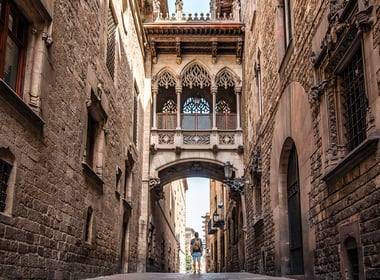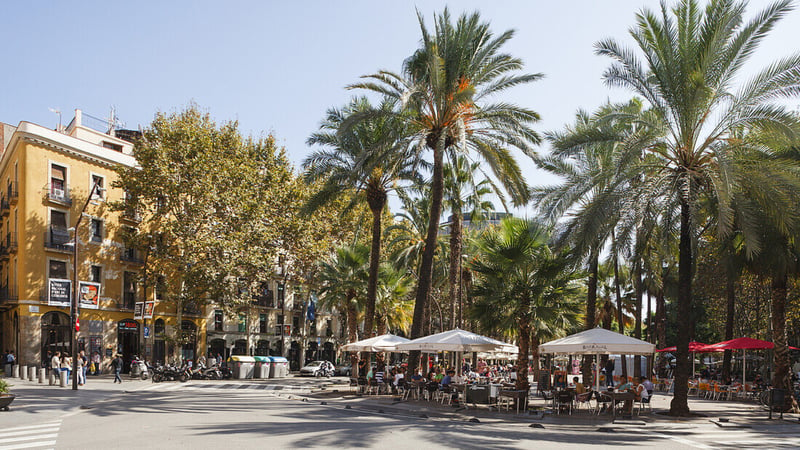İçindekiler
Located to the west of Ciutat Vella, the historic center of Barcelona, El Raval stands out as one of the most colorful and vibrant neighborhoods of the city. With its narrow streets dating back to the Middle Ages, the cultural diversity created by immigrants from different countries and the urban transformation projects completed in recent years, the neighborhood reflects the changing face of Barcelona. Once one of the city’s poorer districts, El Raval has now become one of Barcelona’s most important cultural and artistic centers with its modern art galleries and preserved historical buildings.
History of El Raval
The history of El Raval dates back to the 14th century, when the area outside Barcelona’s first city walls was originally filled with farmland and monasteries. In the 18th century, with the industrial revolution, the neighborhood underwent a major transformation as factories and workers’ housing were built. In 1859, the area, also known as Barri Xino (Chinatown), became one of the most densely populated and problematic areas of the city.
Since the 1980s, urban regeneration projects have given the neighborhood a new identity. Opened in 1995, MACBA (Barcelona Museum of Contemporary Art) and the Centre de Cultura Contemporània de Barcelona (CCCB), which opened in 1994 in the restored historic Casa de la Caritat building, have become icons of the neighborhood’s cultural transformation.
Arts and Culture in El Raval
MACBA (Barcelona Museum of Contemporary Art)
Designed in 1995 by American architect Richard Meier, MACBA stands out with its white modernist architecture. The museum showcases the most important works of contemporary art with its ever-changing exhibitions. The square in front of the building has become a meeting point for skateboard enthusiasts and street artists.

CCCB (Barcelona Center for Contemporary Culture)
Opened in 1994, the center organizes exhibitions, conferences and festivals on urban culture, technology and society. The historic Casa de la Caritat building has been renovated with a modern interpretation and has a terrace with a view of the city.

Filmoteca de Catalunya
Opened in 2012, the sinematek screens restored classic films and serves as a film archive. With its modern building and film library, it is an important center for cinema enthusiasts.
Gastronomy and Nightlife in El Raval
El Raval is one of the most diverse neighborhoods in Barcelona. Restaurants run by Pakistani, Indian, Filipino and Middle Eastern immigrants offer authentic flavors in the neighborhood. Carrer de Joaquín Costa and the surrounding streets in particular are full of local tapas bars and modern restaurants.
La Boqueria Market
Opened in 1840, La Boqueria is Barcelona’s most famous food market, and you can enter through the back door on El Raval and buy fresh juices, local cheeses and charcuterie.
Bar Marsella
Bar Marsella, opened in 1820, is one of the oldest bars in Barcelona and still holds its historical value. The venue, where famous artists such as Ernest Hemingway and Pablo Picasso spent time, brings the atmosphere of the period to the present day with its original 19th century decoration and antique mirrors.
Everyday Life and Shopping in El Raval
The main street of El Raval, Rambla del Raval, was transformed into a wide boulevard with the urban renewal project completed in 2000. Fernando Botero’s famous Cat sculpture has become the symbol of this boulevard. Historic streets like Carrer de l’Hospital and Carrer de Sant Pau are full of vintage shops, record stores and design boutiques.
Botero’s Cat
In the middle of the Rambla del Raval, a huge bronze sculpture of a cat welcomes visitors. Created in 1987 by Colombian artist Fernando Botero and installed here in 2003, “El Gato” (The Cat) has become one of the symbols of the neighborhood. Weighing 2.1 tons and 7 meters long, this cute cat sculpture is considered one of the most important symbols of El Raval’s urban transformation. The bronze cat represents the modern face of El Raval, a favorite spot for those who want to sit, relax, take photos and meet on the neighborhood’s wide boulevard.

Sant Antoni Market
Built in 1882, the modernist market was restored in 2018. The second-hand book market on Sundays is an indispensable address for collectors and book lovers.

Carrer de Tallers
Famous for its vintage clothing stores, record shops and musical instrument shops, the street is the center of alternative culture.
Is El Raval Safe?
Some areas of El Raval require caution, especially at night. Police presence in the area has been increased in recent years and security cameras have been installed. Main streets and tourist areas are generally safe, but unfortunately it is worth being on the lookout for pickpockets on side streets.
El Raval is in a very advantageous location in terms of public transportation, easily accessible from Liceu and Sant Antoni metro stations. The neighborhood is also home to La Rambla, Plaça Catalunya and Barri Gotic, all within walking distance.
El Raval, with all its complex history and cultural richness, remains one of the most interesting neighborhoods in Barcelona. Don’t forget to add this neighborhood to your Barcelona sightseeing list.







